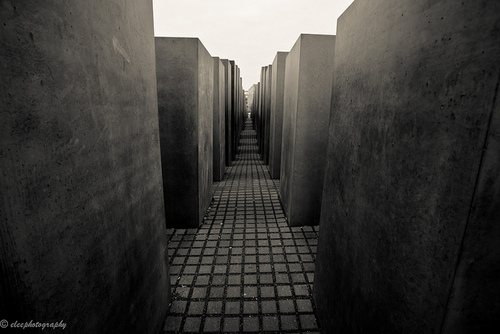The selfie of San Antonio Spurs’ Danny Green at the Memorial to the Murdered Jews of Europe (in Berlin) is making the rounds online. The people of the internet are “outraged,” both, it seems, at the picture itself and at the caption Green wrote: “You know I had to do it one time lol #Holocaust.” Undoubtedly, the pairing of “lol” with “#Holocaust” is insensitive, unthoughtful, and shallow. And, Green responded to the incident by issuing multiple twitter apologies and a new caption: “A lot of history here, more than you could imagine…very sad/tragic things happened #holocaust #berlin.”
But this selfie scandal, if we want to over-estimate its importance in the world, touched a nerve around Holocaust selfies more generally and renewed a conversation about behavior at Concentration Camps, memorials, and other sites of Holocaust memory. Lilit Marcus from the Guardian has published a piece today about Holocaust Selfies and Holocaust Tourism. In the article, she argues:
“For some people, a visit to a place like Auschwitz isn’t about paying respect or learning about history – it’s simply yet another “must-see attraction” they’re checking off in their guidebook, a thing to be Instagrammed, like the Mona Lisa or the Leaning Tower of Pisa.”
While she makes a compelling personal case for not wanting to visit these sites and instead visiting places Jews lived before and after the Holocaust, it seems like there is more to be said here about travel, Holocaust memory, and social media.
So, let me add a few thoughts and raise some questions that I continue to grapple with around these issues:
1) Why do we think there is an “appropriate” way to visit a Concentration Camp? There is not only one lesson we can take from those kinds of experiences and so there cannot be only one solemn and silent way for us to visit these sites.
2) I think it’s important that sites like Auschwitz are preserved and memorials like the one in central Berlin exist. For this to make sense, people need to visit them, interact with them, and consider their place both in the past and in the present. These spaces are meant to confront our understanding of the world, provoke memory so that we think about the present, and we cannot place them under glass and observe them from afar just because they are difficult, emotional, and controversial places.
3) Visitors have long been taking pictures at places like Auschwitz. They serve to document that the place exists, as a testament to the crimes committed there, and as a way for us to contend with the complex history of the space. Selfies feel problematic because they are generally thought to be frivolous and self-indulgent, but again, who are we to judge what the appropriate response and behavior at memorial sites should be. Did Danny Green learn a lesson about history and memory? Maybe. Perhaps what seemed to him obligatory, or just a check off the tourism list, became a moment of self reflection and recognition. And, isn’t this ultimately the goal?
I’m not yet sure how it fits into this conversation, but I’m thinking of Nishant Shah’s thoughtful and critical consideration of the selfie as digital object and its relationship to the self.
For me, the Holocaust selfie doesn’t seem that confusing. In moments when we are confronted with a past that feels overwhelming, confusing, and beyond our understanding, we seek to lighten that burden. We may think about the landscape or the sunshine alongside thinking about the inhumanity of the Holocaust. And the tension between these competing thoughts is not “inappropriate” – it is representative of what it means to confront the Holocaust from our present moment, of finding a way to wrestle with this history while we continue to live our lives.
I’m not saying that Danny Green’s behavior was okay – it was, again, thoughtless and insensitive. But, rather than write this off as inappropriate, I find myself wondering how the space could have engaged him in a way that was more considered, historically minded, and personal. In other words, let’s aim for engagement more than appropriate.
Originally posted on Memories/Motifs Blog >
